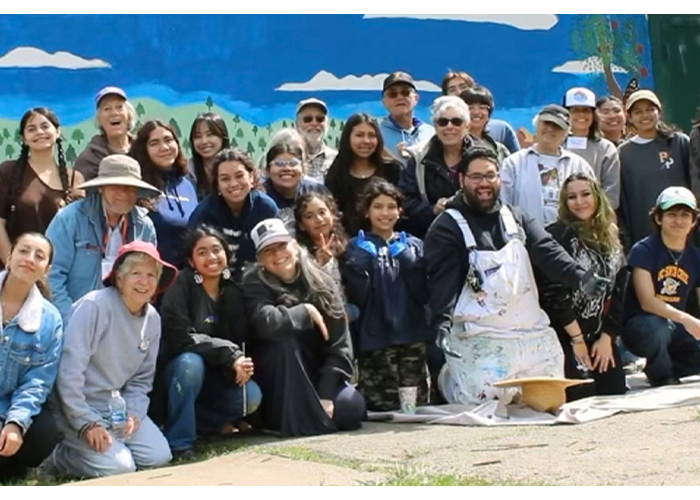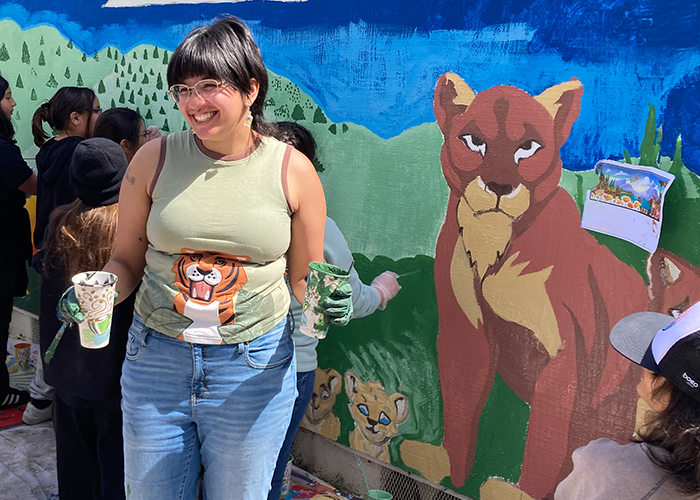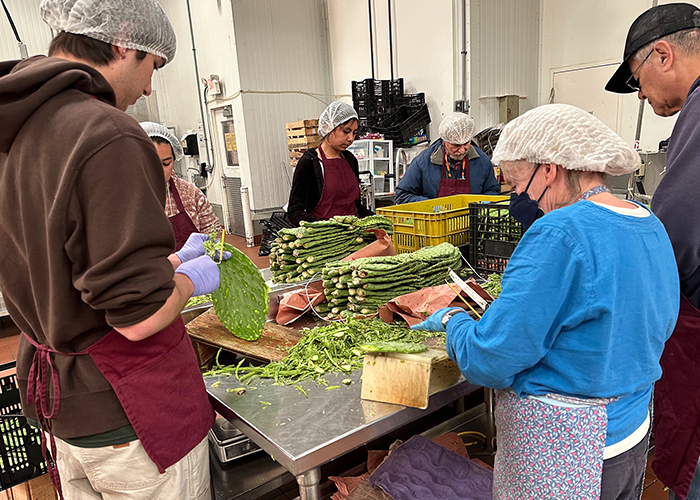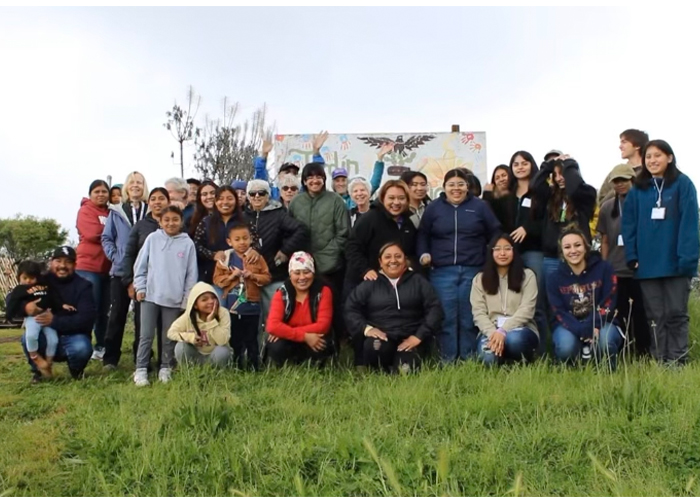For most, spring break brings to mind images of sun-soaked escapades and leisurely mornings. On March 23, fifteen students from UC Santa Cruz decided to redefine the essence of spring break. Opting out of traditional activities, they immersed themselves in a week-long critical service-learning experience, partnering with environmental and economic justice organizations in Watsonville as part of the Colleges Nine and John R. Lewis Alternative Spring Break program.
Program Director Linnea Beckett inherited ASB in 2017 and integrated it as part of the Apprenticeship in Community Engaged Research (H)ACER program at Colleges Nine and John R. Lewis. She re-designed ASB as a critical service-learning program, deepening its commitment to community and social justice. It is designed to showcase justice efforts in Watsonville and South County and encourage undergraduates to work alongside community members and leaders in varying capacities. Students learn about histories of resistance and consider the various ways people work in their community contexts to support health, well-being, dignity, and intergenerational learning. After a temporary hiatus due to the COVID-19 pandemic, Beckett was excited to bring the program back this year.
“[Alternative Spring Break] is really grounded in engagement in horizontal, non-extractive ways,” said Beckett. “It’s not about recreating a dynamic of ‘haves’ and ‘have nots.’ It’s about students going and being in community contexts with real people and real families and working together towards a common goal.”
ASB is a student-led program. Beckett worked with two student leads over the course of five months to create the ASB experience. The ASB leads then took over and ran the program. Given that this was the first ASB since 2019, this years’ student leads took on the challenge of planning the program without prior experience. In preparation for spring break, students attended a weekend-long retreat in February, which consisted of relationship-building among participants, meeting program partners, discussing what critical service learning means, learning from Watsonville leaders, and hearing from past ASB alumni.
“[Past alumni said] they always came back to ASB because the Watsonville community had a place for them that reminded them of home,” said student lead and third-year global and community health major Ali Gutierrez-Esquivel. “What attracted me to ASB was the idea of service learning and learning from a horizontal perspective with Watsonville community members … Watsonville is just around the corner from us and it’s such a vibrant community, and it was a really good opportunity to learn in that way.”
Co-lead and second-year psychology and global and community health major Sahare Rostami Zadeh, echoed Gutierrez’s sentiment. “What drew me to ASB was the ability to be invited into a space where you’re learning from each other and having these really impactful experiences, and seeing how they can affect our surrounding areas like Watsonville.”
Additionally, members of the Osher Lifelong Learning Institute at UC Santa Cruz (OLLI) participated in this year’s ASB. The partnership between OLLI and ASB has existed since 2016, and is a natural fit given OLLI’s long-standing partnership between Colleges Nine and John R. Lewis and their shared commitment to the pursuit of learning. Board member Mark Gordon, who has been a member of OLLI since 2003, spoke about the benefits of working with undergraduate students throughout ASB.
“UC Santa Cruz students are extraordinarily wonderful people,” Gordon said. “We love them, and they have so many wonderful ideas. They’re so deeply engaged in a world that is fraught with awful pressures and fears, I mean everything from climate change to wars and racism and all the difficulties and challenges that we face in the world today. Working together with young people is inspiring and wonderful and it makes us feel hopeful that somehow or someway we will figure some of these things out.”
Day 1: Calabasas Community Garden
Spring break began on Saturday, March 23, with ASB students and OLLI members traveling to the Calabasas Community Garden in Watsonville to assist families with planting. Due to unexpected weather conditions, they changed course and spent the day sharing food and conversation with the community members whose plots they had planned to assist with.
“We got to have long chats with the people that work in the garden and the families that have plots there, so it was really nice,” said Alexander Castaneda, a first-year politics major who participated in ASB. “This gentleman told us a story about putting all of the worms and caterpillars in the bucket in the corner of the garden, and he was laughing and smiling about it and his joy made me feel happy. When I think of community service, I think of helping for just one day, and writing it down on a sheet to get logged hours. But I feel like with ASB, we have honestly spent more time just talking to people in the community. I think that’s really important. The people I’ve met have been super excited for us to come in and talk with them, they’ve been so welcoming and accommodating.”
“Coming into spring, planting season is a lot of work. We wanted to help with that,” Gordon said. “In past years, the weather cooperated, but this year we couldn’t do that. Instead, we met with the families whose garden plots were there and talked about what their hopes were. [The weather] could’ve been a disappointment, but it wasn’t. It was a lovely day.”
Day 2: El Pájaro Community Development Corporation Kitchen Incubator
On Sunday, March 24, they traveled to the El Pájaro Community Development Corporation (CDC) Kitchen Incubator. El Pájaro CDC operates a commercial kitchen that entrepreneurs in the Central Coast can use to help grow and support their food businesses. The ASB students and OLLI members helped local entrepreneurs prepare and assemble food options, such as nopales or cacti.
“We were helping a lot of small businesses,” said third-year politics and environmental studies major Vanessa Canchola. “At the end, we said ‘thank you for showing us your work.’ And they were like, ‘No, thank you for all of your work that you’ve done for us.’ It was really impactful to see that you can make a change in your community through just a few days of work.”
Day 3 - 7: Calabasas Elementary School in Watsonville, Watsonville Brilliante, and Second Harvest
This year marked an additional return to tradition, as the entire community was invited to participate in painting a mural at Calabasas Elementary School in Watsonville on March 24.
Alternative Spring Break’s partnership with Watsonville Community Mural Paint Day began in 2016, when Beckett reached out to local muralist Paul de Worken. De Worken is an established muralist and community organizer in the Central Coast; he has over 35 murals between Santa Cruz and Monterey, and his work is recognizably prominent across Watsonville. In addition to running a small business, Monterey Bay Murals, he also works as a substitute teacher within his community.
“My part of it all is to ask people to paint murals together,” de Worken said. “Let’s do art. If it inspires somebody, then that’s great, and if not then at least they had the chance to do something like that.”
Over the course of the next three days, students volunteered at Calabasas Elementary School’s College Week to answer elementary students’ questions about university life, worked with local artist and activist Kathleen Crocetti of Watsonville Brillante on a mosaic in downtown Watsonville, and sorted food at Second Harvest.
“Colleges 9 and John R. Lewis have themes that are concerned with community and social justice and how we can work together to make our community a richer, better space where people have more opportunities,” Gordon said. “This effort of doing this work is built around those ideas, about how do we come in and not just fix things, but work together to find the strengths that the community offers and build on that. It’s an extraordinary opportunity to rethink the modalities that privileged people have about communities that are oppressed. It really changes everything as you see how incredibly rich and gifted these communities are.”
Reflections and final showcase
For Beckett, this year’s ASB presented an opportunity to return to a tradition that supports ongoing community partnerships with Colleges Nine and John R. Lewis. ASB is just one of a series of programs that works with these partners in varying capacities in mutually beneficial and sustaining ways.
“ASB is just one piece of a larger work that we’re doing here at Colleges 9 and John R. Lewis to building relationships with community partners that are in the county, that are mutually beneficial and sustainable, ones that really uplift the powerful work that the community members are doing and also provide an opportunity for students to get off campus and be in contexts that are not university contexts,” Beckett said.
She continued, “It can sometimes be hard as a student to navigate all the stresses that come along with university life. It’s very intentional that ASB is not just a tour, it’s about having a space for real connection among people. I think the connection happens, and it further supports the community engagement work that we do at the colleges, but it also creates space for students to be with people in authentic ways that are off campus, outside, and in different contexts that can be really rejuvenating.”
At the end of the week, students completed closing activities and reflected on their experiences. On April 27, students will present their final projects, including reflective essays and art pieces, to showcase their work within the group and to the UC Santa Cruz community. The event is open to ASB participants and OLLI and community partners involved in the program, and will be held at the Recreational Lounge on April 27 from 1-3 p.m.
Interested in participating in ASB? Students who would like to participate in next year’s ASB can expect to see informational sessions at the beginning of January. Since the class spans winter and spring quarters, enrollment occurs in winter with course credit awarded in spring. The informational sessions provide essential details about the application process and overall structure of ASB. Learn more.






